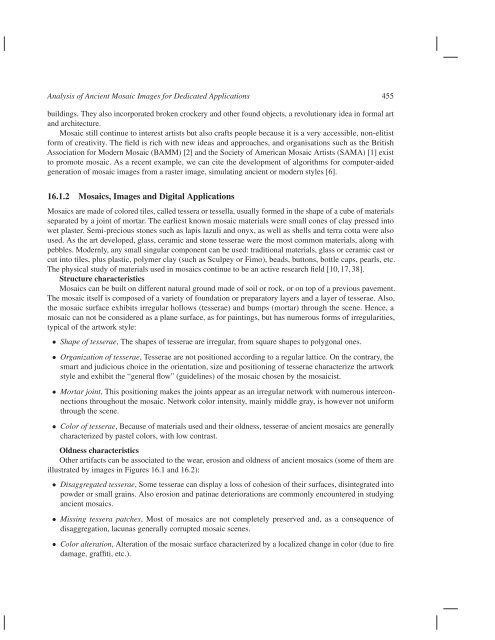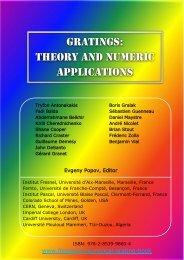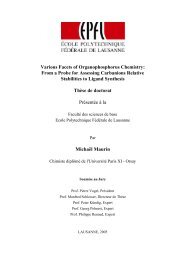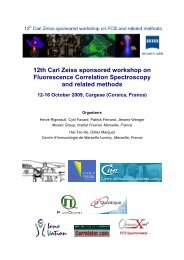Analysis of Ancient Mosaic Images for Dedicated ... - Institut Fresnel
Analysis of Ancient Mosaic Images for Dedicated ... - Institut Fresnel
Analysis of Ancient Mosaic Images for Dedicated ... - Institut Fresnel
Create successful ePaper yourself
Turn your PDF publications into a flip-book with our unique Google optimized e-Paper software.
<strong>Analysis</strong> <strong>of</strong> <strong>Ancient</strong> <strong>Mosaic</strong> <strong>Images</strong> <strong>for</strong> <strong>Dedicated</strong> Applications 455<br />
buildings. They also incorporated broken crockery and other found objects, a revolutionary idea in <strong>for</strong>mal art<br />
and architecture.<br />
<strong>Mosaic</strong> still continue to interest artists but also crafts people because it is a very accessible, non-elitist<br />
<strong>for</strong>m <strong>of</strong> creativity. The field is rich with new ideas and approaches, and organisations such as the British<br />
Association <strong>for</strong> Modern <strong>Mosaic</strong> (BAMM) [2] and the Society <strong>of</strong> American <strong>Mosaic</strong> Artists (SAMA) [1] exist<br />
to promote mosaic. As a recent example, we can cite the development <strong>of</strong> algorithms <strong>for</strong> computer-aided<br />
generation <strong>of</strong> mosaic images from a raster image, simulating ancient or modern styles [6].<br />
16.1.2 <strong>Mosaic</strong>s, <strong>Images</strong> and Digital Applications<br />
<strong>Mosaic</strong>s are made <strong>of</strong> colored tiles, called tessera or tessella, usually <strong>for</strong>med in the shape <strong>of</strong> a cube <strong>of</strong> materials<br />
separated by a joint <strong>of</strong> mortar. The earliest known mosaic materials were small cones <strong>of</strong> clay pressed into<br />
wet plaster. Semi-precious stones such as lapis lazuli and onyx, as well as shells and terra cotta were also<br />
used. As the art developed, glass, ceramic and stone tesserae were the most common materials, along with<br />
pebbles. Modernly, any small singular component can be used: traditional materials, glass or ceramic cast or<br />
cut into tiles, plus plastic, polymer clay (such as Sculpey or Fimo), beads, buttons, bottle caps, pearls, etc.<br />
The physical study <strong>of</strong> materials used in mosaics continue to be an active research field [10, 17, 38].<br />
Structure characteristics<br />
<strong>Mosaic</strong>s can be built on different natural ground made <strong>of</strong> soil or rock, or on top <strong>of</strong> a previous pavement.<br />
The mosaic itself is composed <strong>of</strong> a variety <strong>of</strong> foundation or preparatory layers and a layer <strong>of</strong> tesserae. Also,<br />
the mosaic surface exhibits irregular hollows (tesserae) and bumps (mortar) through the scene. Hence, a<br />
mosaic can not be considered as a plane surface, as <strong>for</strong> paintings, but has numerous <strong>for</strong>ms <strong>of</strong> irregularities,<br />
typical <strong>of</strong> the artwork style:<br />
• Shape <strong>of</strong> tesserae, The shapes <strong>of</strong> tesserae are irregular, from square shapes to polygonal ones.<br />
• Organization <strong>of</strong> tesserae, Tesserae are not positioned according to a regular lattice. On the contrary, the<br />
smart and judicious choice in the orientation, size and positioning <strong>of</strong> tesserae characterize the artwork<br />
style and exhibit the “general flow” (guidelines) <strong>of</strong> the mosaic chosen by the mosaicist.<br />
• Mortar joint, This positioning makes the joints appear as an irregular network with numerous interconnections<br />
throughout the mosaic. Network color intensity, mainly middle gray, is however not uni<strong>for</strong>m<br />
through the scene.<br />
• Color <strong>of</strong> tesserae, Because <strong>of</strong> materials used and their oldness, tesserae <strong>of</strong> ancient mosaics are generally<br />
characterized by pastel colors, with low contrast.<br />
Oldness characteristics<br />
Other artifacts can be associated to the wear, erosion and oldness <strong>of</strong> ancient mosaics (some <strong>of</strong> them are<br />
illustrated by images in Figures 16.1 and 16.2):<br />
• Disaggregated tesserae, Some tesserae can display a loss <strong>of</strong> cohesion <strong>of</strong> their surfaces, disintegrated into<br />
powder or small grains. Also erosion and patinae deteriorations are commonly encountered in studying<br />
ancient mosaics.<br />
• Missing tessera patches, Most <strong>of</strong> mosaics are not completely preserved and, as a consequence <strong>of</strong><br />
disaggregation, lacunas generally corrupted mosaic scenes.<br />
• Color alteration, Alteration <strong>of</strong> the mosaic surface characterized by a localized change in color (due to fire<br />
damage, graffiti, etc.).













